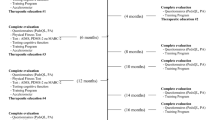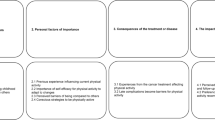Abstract
Purpose
The evidence demonstrating the benefits of exercise and PA in patients and survivors of childhood cancer has been translated into a handful of community-based programs, such as the Pediatric cancer patients and survivors Engaging in Exercise for Recovery Program (PEER). To support the translation of research to practice, the next step in knowledge translation is to evaluate program effectiveness. An evaluation must consider the goals of the PEER program, feedback from key stakeholders, and logistics of this program. Thus, the purpose of this study was to develop an evaluation toolkit with an algorithm for the implementation of the PEER program.
Methods
Semi-structured interviews were conducted with three different groups (stakeholders in pediatric oncology, PEER parents, and PEER participants). The interviews were transcribed and coded by two independent reviewers.
Results
Key themes extracted from the interviews were split into physical and psychosocial themes. The most reported psychosocial themes were quality of life (QOL), fatigue/energy levels, fun, and cs; and physical themes included motor skills, physical literacy, and physical activity levels. Tools were compiled into the evaluation based on key themes identified as well as logistics of PEER. An algorithm was developed to tailor the evaluation to participants based on age and mobility.
Conclusion
To date, this is the first evaluation toolkit and algorithm developed for a specific community-based PA program, the PEER program. The next step in knowledge translation will be to implement the evaluation to assess feasibility and share the evaluation for adoption within other developing programs.
Similar content being viewed by others
Data availability
All identifying information was removed from data before manuscript preparation. Participants who were interested in study results will be provided with the final manuscript.
Code availability
Not applicable.
References
Chamorro Vina C, Wurz AJ, Culos-Reed SN (2013) Promoting physical activity in pediatric oncology. Where do we go from here? Front Oncol 3:173
Oeffinger KC, Mertens AC, Sklar CA et al (2006) Chronic health conditions in adult survivors of childhood cancer. N Engl J Med 355:1572–1582
Chamorro-Viña C, Keats M, Culos-Reed SN (2014) Pediatric Oncology Exercise Manual (POEM). Health & Wellness Lab Faculty of Kinesiology, University of Calgary, Calgary, AB
Chamorro Viña C, Guilcher GMT, Schulte F et al (2017) Description of a community-based exercise program for children with cancer: a sustainable, safe, and feasible model. Rehabil Oncol 35:24–37
Kronlund LJ (2018) Addressing key stakeholders to assess the reach of a community-based pediatric oncology physical activity program. University of Calgary, Calgary, AB
Shank J, Chamorro-Vina C, Guilcher GMT et al (2020) Evaluation tools for physical activity programs for childhood cancer: a scoping review. J Pediatr Oncol Nurs 37:163–179
Braun V, Clarke V (2012) Thematic analysis. In: Cooper H, Camic PM, Long DL, Panter AT, Rindskopf D, Sher KJ (eds) APA handbook of research methods in psychology, vol 2. Research designs: Quantitative, qualitative, neuropsychological, and biological. American Psychological Association, Washington, DC, pp 57–71
Malina RM (2004) Motor development during infancy and early childhood: overview and suggested directions for research. Int J Sport Health Sci 2:50–66
Russell D, Rosenbaum P, Gowland C et al (1993) Gross motor function measure. McMaster University Toronto, Ontario, Canada
Bruininks RH, Bruininks BD (2005) Bruininks-Oseretsky test of motor proficiency, Second Edition (BOT-2) [Database record]. APA PsycTests. https://doi.org/10.1037/t14991-000
Götte M, Kesting S, Albrecht C et al (2013) MOON-test–determination of motor performance in the pediatric oncology. Klin Padiatr 225:133–137
Smits-Engelsman BCM, Fiers MJ, Henderson SE, Henderson L (2008) Interrater reliability of the movement assessment battery for children. Phys Ther 88:286–294
International Physical Literacy Association (2017) Definition of physical literacy. https://www.physical-literacy.org.uk/?v=3e8d115eb4b3. Accessed 15 Feb 2022
Sport for Life Society (2018) Physical literacy assessment for youth. https://play.physicalliteracy.ca/play-tools. Accessed 8 Dec 2021
Caldwell HA, di Cristofaro NA, Cairney J et al (2021) Measurement properties of the Physical Literacy Assessment for Youth (PLAY) tools. Appl Physiol Nutr Metab 99:1–8
Kid Sense Child Development Corporation Pty Ltd © 2021 Gross motor development chart. https://childdevelopment.com.au/resources/child-development-charts/gross-motor-developmental-chart/. Accessed 8 Dec 2021
Sport for life an introduction to physical literacy. https://assets.website-files.com/5d24fc966ad064837947a33b/5e0fc32c98f2dcf28fcf68ce_Introduction%20to%20Physical%20Literacy.pdf. Accessed 16 Feb 2022
Varni JW, Burwinkle TM, Katz ER et al (2002) The PedsQL™ in pediatric cancer: reliability and validity of the pediatric quality of life inventory™ generic core scales, multidimensional fatigue scale, and cancer module. Cancer 94:2090–2106
Chalder T, Berelowitz G, Pawlikowska T et al (1993) Development of a fatigue scale. J Psychosom Res 37:147–153
Sung L, Greenberg ML, Doyle JJ et al (2003) Construct validation of the Health Utilities Index and the Child Health Questionnaire in children undergoing cancer chemotherapy. Br J Cancer 88:1185–1190
Ravens-Sieberer U, Bullinger M (1998) Assessing health-related quality of life in chronically ill children with the German KINDL: first psychometric and content analytical results. Qual Life Res 7:399–407
Wurz A, McLaughlin E, Chamorro Viña C et al (2021) Advancing the field of pediatric exercise oncology: research and innovation needs. Curr Oncol 28:619–629
Funding
This research study was funded by the Canadian Institute of Health Research (CIHR) and the Alberta Children’s Hospital Research Institute (ACHRI).
Author information
Authors and Affiliations
Contributions
Ms. Shank conducted the research project for her MSc thesis and wrote the manuscript. Dr. Chamorro-Viña assisted with data collection and provided feedback and guidance throughout. Dr. Guilcher and Dr. Schulte were mentors and provided feedback on Ms. Shank’s thesis. Dr. Culos-Reed was Ms. Shank’s MSc supervisor and provided feedback and mentorship throughout her graduate work.
Corresponding author
Ethics declarations
Ethics approval
This research study was approved through the University of Calgary Research Ethics Board (HREBA.CC-17–0094).
Consent to participate
All participants signed an informed consent or assent form. All participants were informed; they may withdraw from participation at any point.
Consent for publication
All participants were informed about the research project and that data would be published, which was outlined in the informed consent form. If participants were interested in published results, this would be provided to them upon publication.
Conflict of interest
The authors declare no competing interests.
Additional information
Publisher's Note
Springer Nature remains neutral with regard to jurisdictional claims in published maps and institutional affiliations.
Supplementary Information
Below is the link to the electronic supplementary material.
Rights and permissions
About this article
Cite this article
Shank, J., Chamorro-Viña, C., Guilcher, G.M.T. et al. Development of a functional and psychosocial evaluation toolkit using mixed methodology in a community-based physical activity program for childhood cancer survivors. Support Care Cancer 30, 8101–8110 (2022). https://doi.org/10.1007/s00520-022-07219-8
Received:
Accepted:
Published:
Issue Date:
DOI: https://doi.org/10.1007/s00520-022-07219-8




